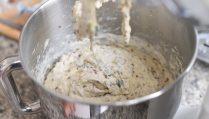When you’re searching for a recipe to bake, cake or bread and you finally come up with a recipe you want, don’t you have the feeling that whatever yeast the recipe deems, you just have the other kind? if so, fresh yeast vs. dry yeast article is just for you.
First let’s make some order in this mess, we have 3 kind of popular yeast in the market, fresh yeast that look like a sponge or small cake, active dry yeast and instant yeast (also known as rapid rise yeast). Here’s a spoiler, there are all just as good and will do the job however quantities and time frames are different, so certain recipes can ask for a different kind of yeast, in 99% of the cases, you can replace the recipe yeast with what you have at home, but pay attention to time frames and conversion quantities of fresh Yeast vs. Dry yeast, I’ll mention in this article.
Fresh Yeast
Soft and solid beige color yeast with 70% moisture, it is also known as cake yeast or compressed yeast.
Fresh yeast has a short-term shelf life, 3-4 weeks in a regular fridge, this makes them unavailable in many stores and a must to use within a certain time frame.
Fresh yeast can be added directly to the dry ingredients by small chunks or added to warm water with sugar or honey to wake them up and afterwards added to the dough.
Active dry yeast
The most popular yeast in use today, it looks as a fairly big granule of yeast in a gray brownish color.
Active dry yeast can be stored in the fridge for 2 years or in the freezer for a decade, which makes this kind of yeast very comfortable yeast type for the home amature baker.
Active dry yeast needs to be dissolved in water before used in a recipe.
Instant Yeast
Another kind of the dry yeast family, these yeast are processed much like the active dry yeast however they are milled into finer granules. The result of this is that they are absorbed in the dough much more quickly and does not needed to be dissolved in water, just add them to the dry ingredients.
Instant yeast are added with enzymes that makes the dough proof faster and in an efficient way that according to the manufacturers, when making a bread we can skip the second proofing and just shape the loaves after the first one.
My personal opinion is that Instant yeast can be used Only for bread machines loaves and not when making regular bread, it can be suitable for pound cakes as well.
Fresh yeast to dry yeast conversion
I read a lot of different conversions regarding fresh-dry yeast conversion however it is quite simple, the formula is just multiply or divide the quantities by 3.
1 gram of dry yeast = 3 grams of fresh yeast, so if a recipe deeps for 10 grams of dry yeast we need to use 30 grams of fresh yeast.
You can remember this in another way, 10 grams of fresh yeast = 1 teaspoon of dry yeast (3.3 grams).
Fresh Yeast vs. Dry Yeast – which one to use?
I’m sure anyone who reads professional baking literature will say that fresh yeast are superior to dry yeast, I respect this opinion since many professional bakers are working with fresh yeast however for the weekly home baker the difference is little and hardly noticeable.
One claim is that fresh yeast just taste better when making bread, I agree with that claim however the difference is very small, not worth going to a grocery store 30 minutes from your house especially to buy fresh yeast.
Another claim is that the fresh yeast proof the dough faster and more efficient, this might be true in some cases since dry yeast have a percentage of dead cells that will not proof the dough so in fact you are using less yeast than the dough requires, but other than I see no difference.
At the end of the day, it all depends on what you’re trying to make, for breads I would consider to use the fresh yeast if you have it at home but I wouldn’t bother in using them on cakes, just use the active dry yeast, one thing is certain, avoid from the rapid rise yeast unless you’re in a hurry, always remember, proofing is not just giving the dough its size, it is a heavy enzyme activity that requires time and time equals to flavor, shortening this procedure will resolve in a flat pale taste.
Happy baking!














